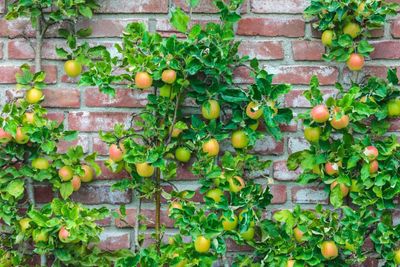Using Fruit Trees as Hedges
Dispense with the traditional boxwood and privet. There are plenty of fruit tree varieties that can make hedges. Hedge fruit tree varieties are not only edible but mark a boundary between one garden and the next, act as a windbreak, provide a backdrop to flower borders, accent a wall, and mute intrusive outside noise all while creating an eye-pleasing secret garden. First of all, when growing fruit tree hedges, you need to consider whether you wish to stick to one species for your hedge or whether you want to mix it up and plant several. A single species hedge looks tidier and more uniform while a mixed species hedge adds visual interest with differing shapes, textures, and colors, plus you have more edible options.
Hedge Fruit Tree Varieties
Some fruit trees are more accurately bushes and with very little care easily grow together to form an impenetrable hedge. Take bush plums or myrobalan plum, for example. This fast-growing tree or bush grows to between 4 and 6 feet (1-2 m.) in height and width. The fruit can be eaten fresh or turned into wines, liqueurs, or preserves. This plant is so apropos for use as a fruit tree that it can make hedges; it was originally cultivated to create orchard shelterbelts. The stunning pale-pink blooms lure pollinating insects to the garden ready to pollinate other fruiting trees. Plant a selection of seedlings to ensure pollination and fruiting.
The Natal plum, an evergreen with white blossoms and small red fruit, is another type of fruit tree that can be used for hedges. The largest varieties of Natal plum can grow up to 8 feet (2 m.). The delicious berries make excellent jams and jellies. Both currants and gooseberries are excellent low growing hedge fruit tree varieties, chock full of juicy fruit perfect eaten fresh or juiced. Crabapples also make an excellent hedge with a profusion of flowers and fruit. Crabapples, while too sour to eat on their own, make excellent jelly. Wildlife flock to this plant including all manner of beneficial insects. Some plants that are traditionally considered only ornamental are actually edible. An example of this is the pineapple guava. Native to South America, this specimen bears fruit described as a fusion between strawberry and pineapple. Other types of fruit trees for hedges may include a combination. For instance, combine plum, apple, and pear trees for an edible hedge. Quince trees also make excellent hedge plantings. The fragrant fruit goes well with apples in a pie, so why not combine the two.
Speaking of apples, many fruit trees can be trained to form a hedge and can be mixed and matched. This practice is called espalier, which is the practice of controlling woody growth for the production of fruit by pruning and tying branches to a frame. Belgian fence is a more complicated method of espalier in which tree limbs are trained into a lattice-like pattern. A little more time consuming than letting some bushes grow together but stunning in the effect and well worth the time. You can espalier apples, cherries, peaches, figs, pears, and citrus trees to create an edible fence. To maximize space even more and increase your bounty, try under-planting with edible plants such as blueberries. You could have a few types of rock fruit or apple varieties growing espaliered at a higher level and closer to ground level several lowbush blueberries.
